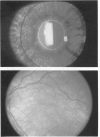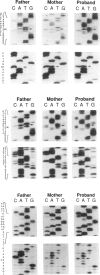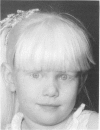Abstract
Mutations in the gene for the pigment-producing enzyme tyrosinase are responsible for type IA (tyrosinase-negative) oculocutaneous albinism (OCA). Most reported mutations have been single base substitutions. We now report three different frameshift mutations in three unrelated individuals with type IA OCA. The first individual has a single base deletion within a series of five guanidines, resulting in a premature stop codon in exon I on one allele and a missense mutation at codon 382 in exon III on the homologous allele. The second individual is a genetic compound of two separate frameshift mutations, including both the same exon I single base deletion found in the first individual and a deletion of a thymidine-guanidine pair, within the sequence GTGTG, forming a termination codon (TAG) in exon I on the homologous allele. The third individual has a single base insertion in exon I on one allele and a missense mutation at codon 373 in exon III on the homologous allele. The two missense mutations occur within the copper Bbinding region and may interfere with either copper binding to the enzyme or oxygen binding to the copper. These five different mutations disrupt tyrosinase function and are associated with a total lack of melanin biosynthesis.
Full text
PDF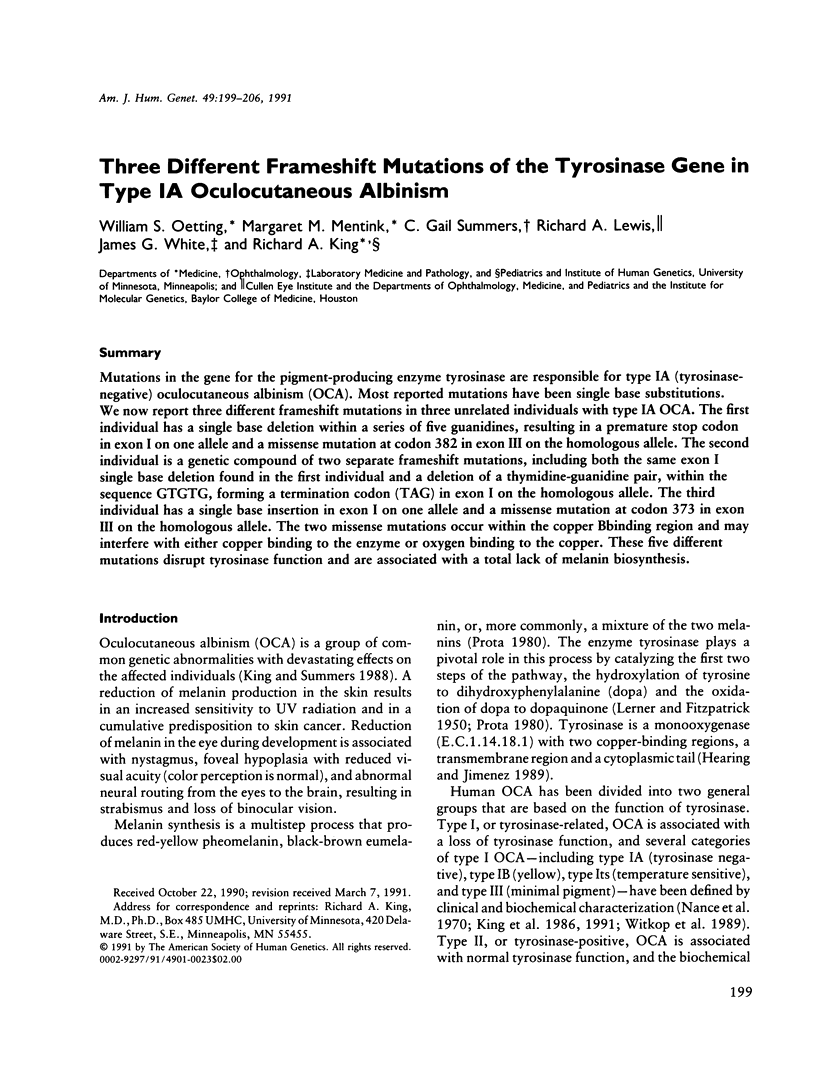
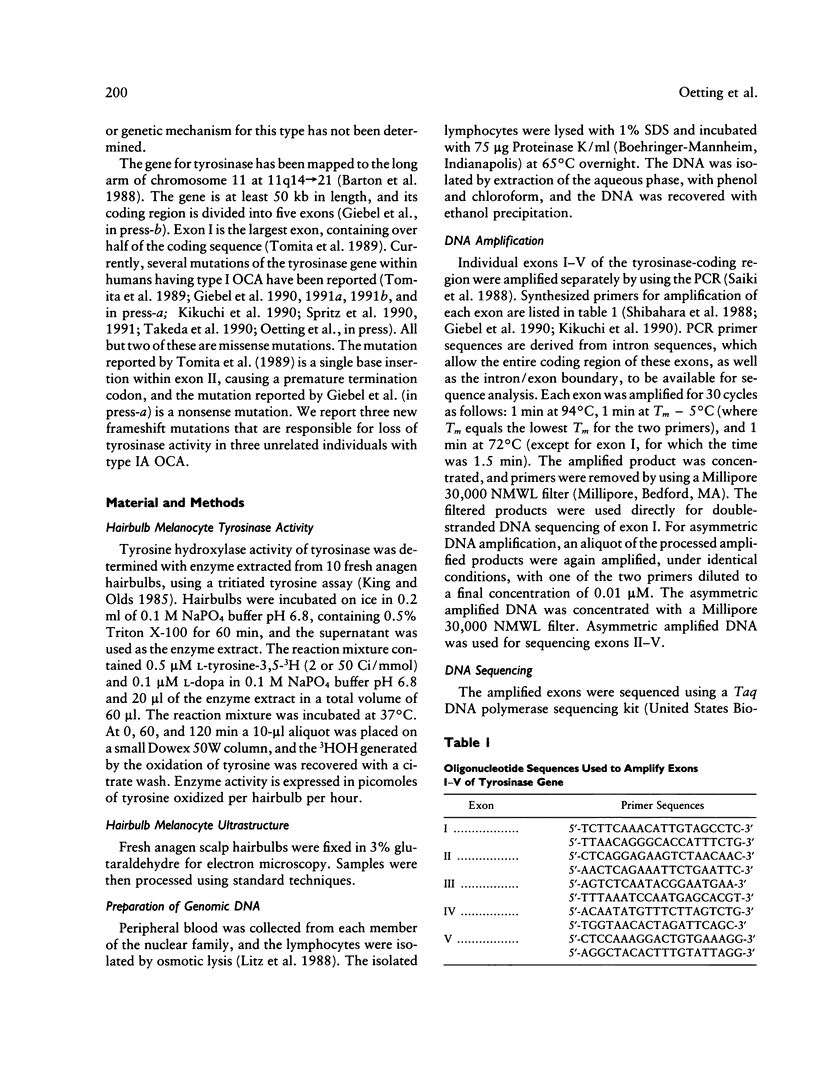
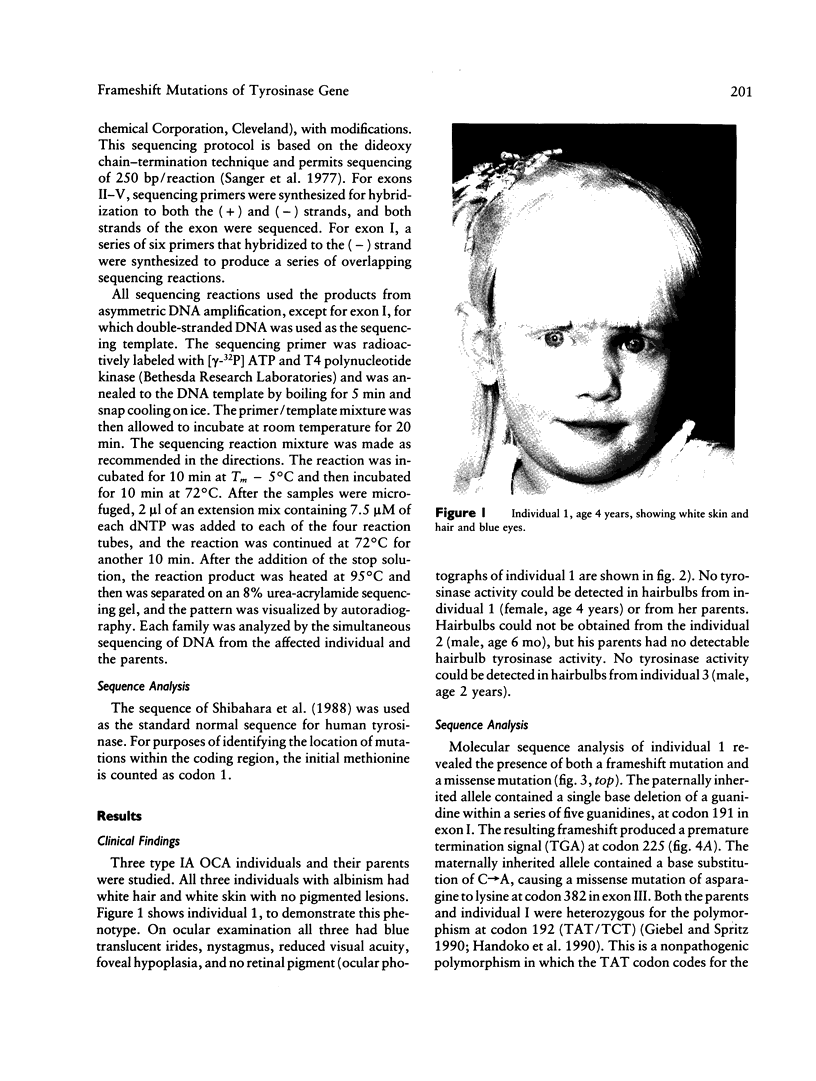
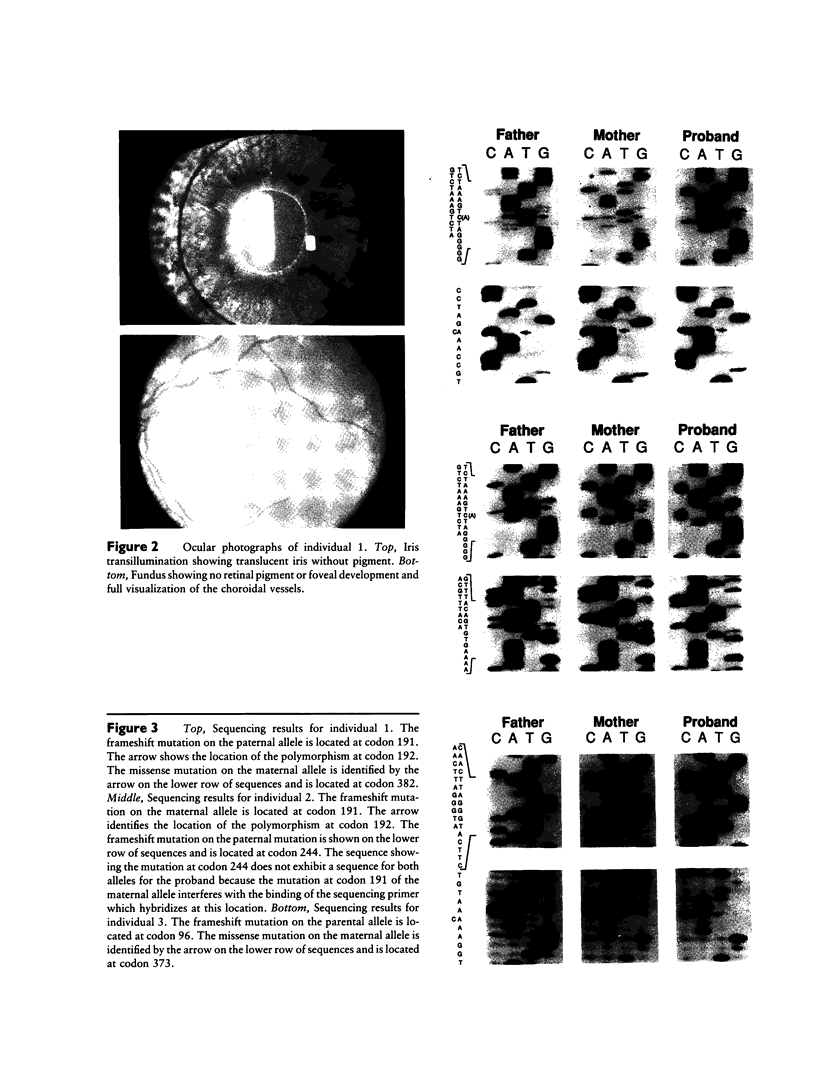
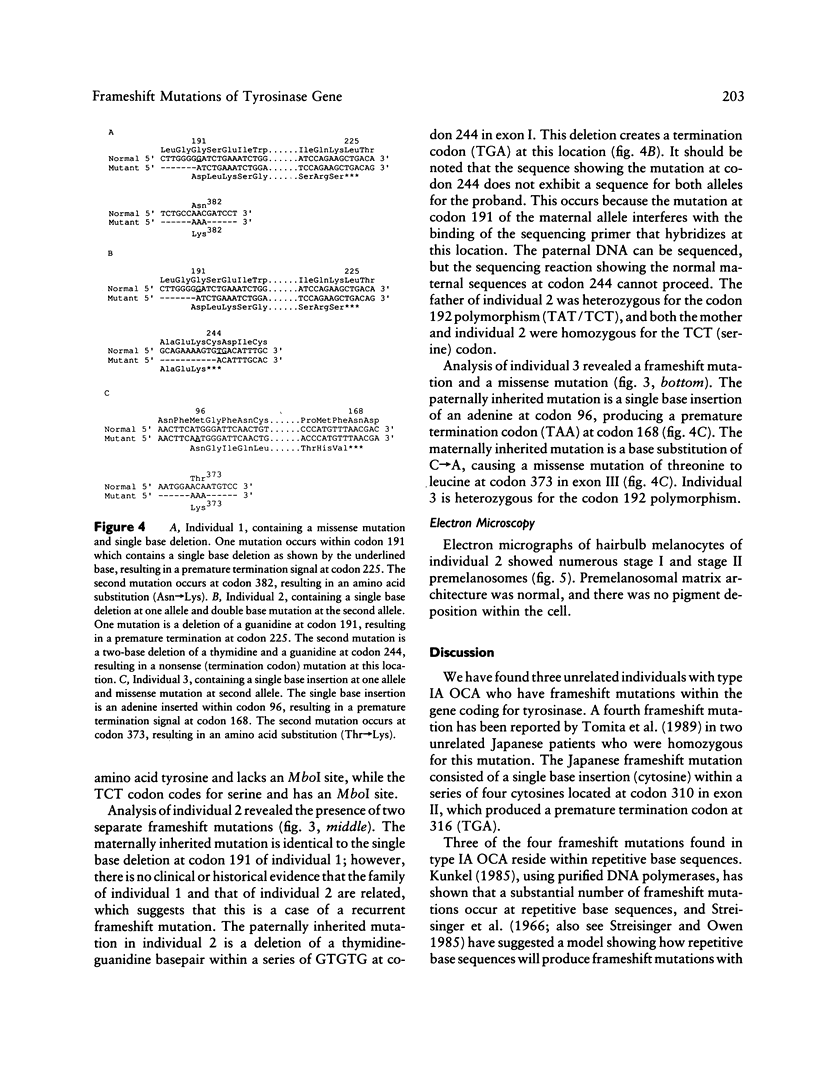
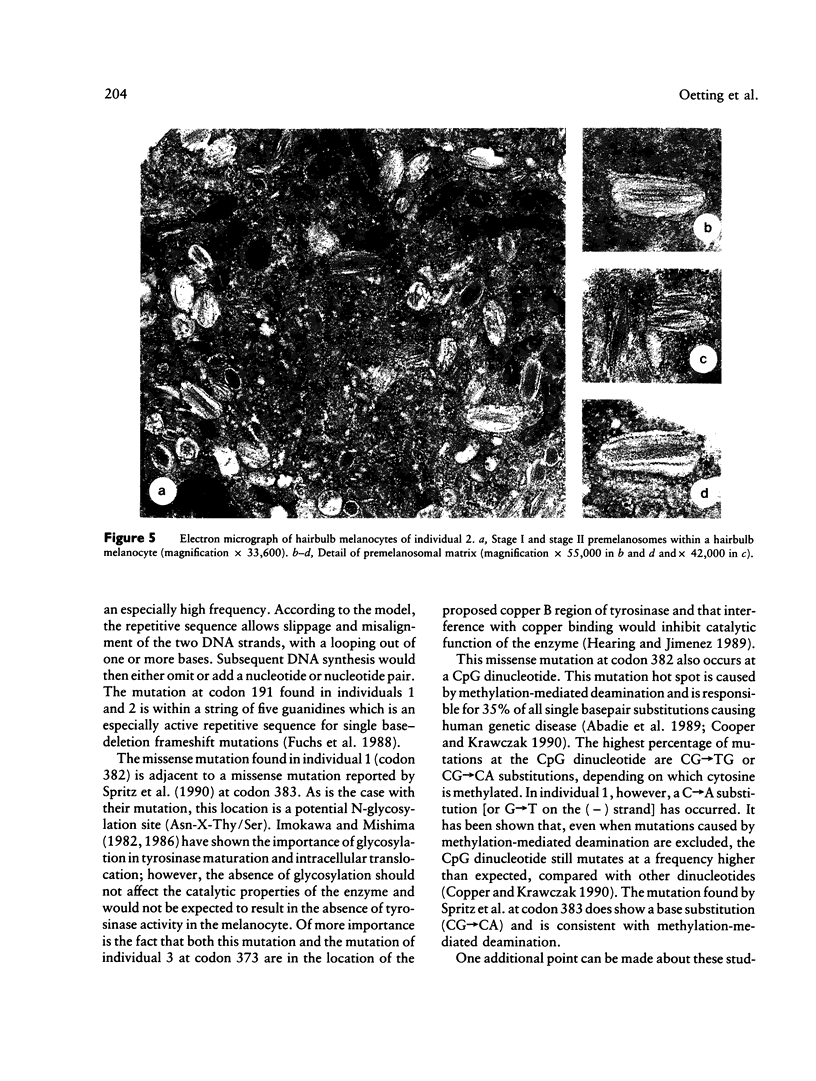
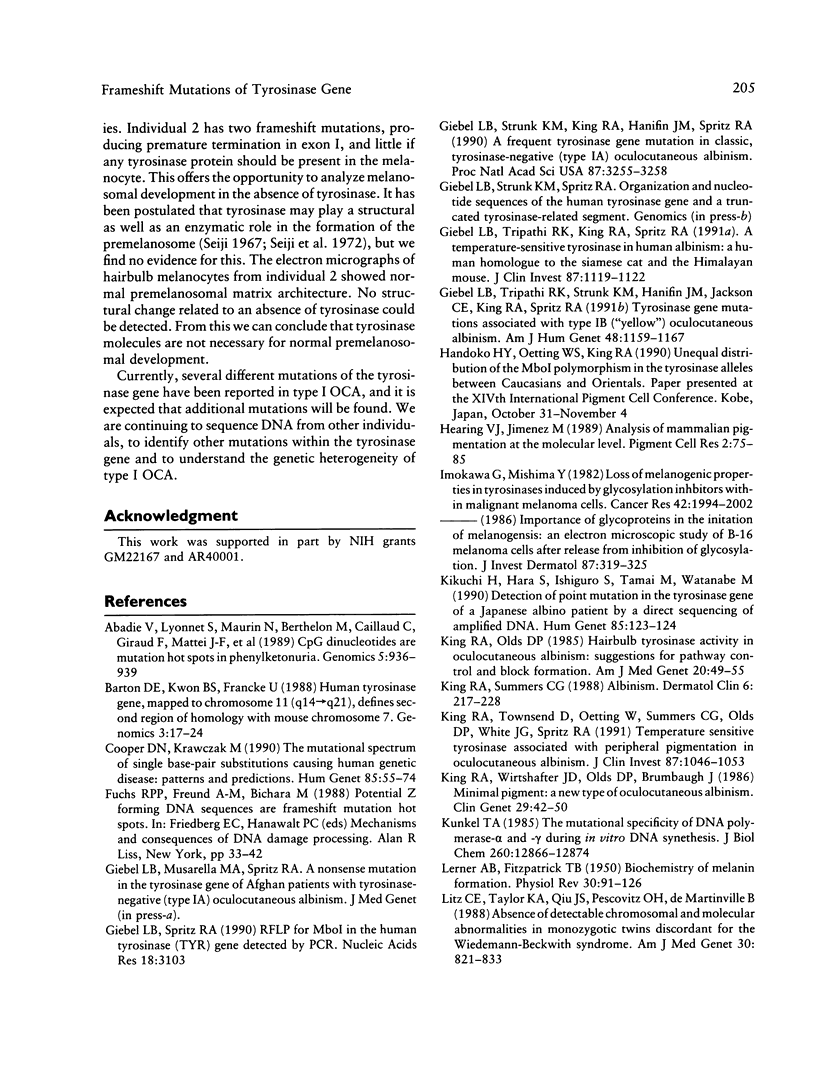
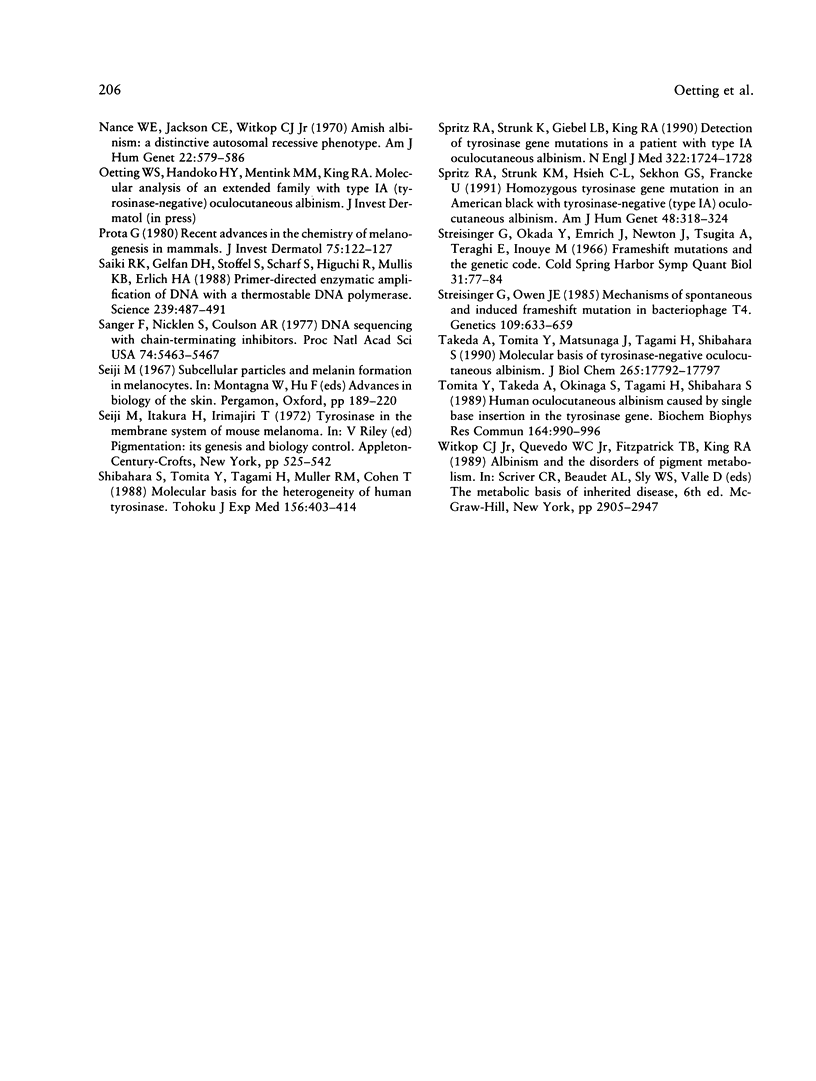
Images in this article
Selected References
These references are in PubMed. This may not be the complete list of references from this article.
- Abadie V., Lyonnet S., Maurin N., Berthelon M., Caillaud C., Giraud F., Mattei J. F., Rey J., Rey F., Munnich A. CpG dinucleotides are mutation hot spots in phenylketonuria. Genomics. 1989 Nov;5(4):936–939. doi: 10.1016/0888-7543(89)90137-7. [DOI] [PubMed] [Google Scholar]
- Barton D. E., Kwon B. S., Francke U. Human tyrosinase gene, mapped to chromosome 11 (q14----q21), defines second region of homology with mouse chromosome 7. Genomics. 1988 Jul;3(1):17–24. doi: 10.1016/0888-7543(88)90153-x. [DOI] [PubMed] [Google Scholar]
- Cooper D. N., Krawczak M. The mutational spectrum of single base-pair substitutions causing human genetic disease: patterns and predictions. Hum Genet. 1990 Jun;85(1):55–74. doi: 10.1007/BF00276326. [DOI] [PubMed] [Google Scholar]
- Giebel L. B., Spritz R. A. RFLP for MboI in the human tyrosinase (TYR) gene detected by PCR. Nucleic Acids Res. 1990 May 25;18(10):3103–3103. doi: 10.1093/nar/18.10.3103-a. [DOI] [PMC free article] [PubMed] [Google Scholar]
- Giebel L. B., Tripathi R. K., King R. A., Spritz R. A. A tyrosinase gene missense mutation in temperature-sensitive type I oculocutaneous albinism. A human homologue to the Siamese cat and the Himalayan mouse. J Clin Invest. 1991 Mar;87(3):1119–1122. doi: 10.1172/JCI115075. [DOI] [PMC free article] [PubMed] [Google Scholar]
- Giebel L. B., Tripathi R. K., Strunk K. M., Hanifin J. M., Jackson C. E., King R. A., Spritz R. A. Tyrosinase gene mutations associated with type IB ("yellow") oculocutaneous albinism. Am J Hum Genet. 1991 Jun;48(6):1159–1167. [PMC free article] [PubMed] [Google Scholar]
- Hearing V. J., Jiménez M. Analysis of mammalian pigmentation at the molecular level. Pigment Cell Res. 1989 Mar-Apr;2(2):75–85. doi: 10.1111/j.1600-0749.1989.tb00166.x. [DOI] [PubMed] [Google Scholar]
- Imokawa G., Mishima Y. Loss of melanogenic properties in tyrosinases induced by glucosylation inhibitors within malignant melanoma cells. Cancer Res. 1982 May;42(5):1994–2002. [PubMed] [Google Scholar]
- Kikuchi H., Hara S., Ishiguro S., Tamai M., Watanabe M. Detection of point mutation in the tyrosinase gene of a Japanese albino patient by a direct sequencing of amplified DNA. Hum Genet. 1990 Jun;85(1):123–124. doi: 10.1007/BF00276337. [DOI] [PubMed] [Google Scholar]
- King R. A., Olds D. P. Hairbulb tyrosinase activity in oculocutaneous albinism: suggestions for pathway control and block location. Am J Med Genet. 1985 Jan;20(1):49–55. doi: 10.1002/ajmg.1320200108. [DOI] [PubMed] [Google Scholar]
- King R. A., Summers C. G. Albinism. Dermatol Clin. 1988 Apr;6(2):217–228. [PubMed] [Google Scholar]
- King R. A., Townsend D., Oetting W., Summers C. G., Olds D. P., White J. G., Spritz R. A. Temperature-sensitive tyrosinase associated with peripheral pigmentation in oculocutaneous albinism. J Clin Invest. 1991 Mar;87(3):1046–1053. doi: 10.1172/JCI115064. [DOI] [PMC free article] [PubMed] [Google Scholar]
- King R. A., Wirtschafter J. D., Olds D. P., Brumbaugh J. Minimal pigment: a new type of oculocutaneous albinism. Clin Genet. 1986 Jan;29(1):42–50. doi: 10.1111/j.1399-0004.1986.tb00769.x. [DOI] [PubMed] [Google Scholar]
- Kunkel T. A. The mutational specificity of DNA polymerases-alpha and -gamma during in vitro DNA synthesis. J Biol Chem. 1985 Oct 15;260(23):12866–12874. [PubMed] [Google Scholar]
- LERNER A. B., FITZPATRICK T. B. Biochemistry of melanin formation. Physiol Rev. 1950 Jan;30(1):91–126. doi: 10.1152/physrev.1950.30.1.91. [DOI] [PubMed] [Google Scholar]
- Litz C. E., Taylor K. A., Qiu J. S., Pescovitz O. H., de Martinville B. Absence of detectable chromosomal and molecular abnormalities in monozygotic twins discordant for the Wiedemann-Beckwith syndrome. Am J Med Genet. 1988 Jul;30(3):821–833. doi: 10.1002/ajmg.1320300316. [DOI] [PubMed] [Google Scholar]
- Nance W. E., Jackson C. E., Witkop C. J., Jr Amish albinism: a distinctive autosomal recessive phenotype. Am J Hum Genet. 1970 Sep;22(5):579–586. [PMC free article] [PubMed] [Google Scholar]
- Prota G. Recent advances in the chemistry of melanogenesis in mammals. J Invest Dermatol. 1980 Jul;75(1):122–127. doi: 10.1111/1523-1747.ep12521344. [DOI] [PubMed] [Google Scholar]
- Saiki R. K., Gelfand D. H., Stoffel S., Scharf S. J., Higuchi R., Horn G. T., Mullis K. B., Erlich H. A. Primer-directed enzymatic amplification of DNA with a thermostable DNA polymerase. Science. 1988 Jan 29;239(4839):487–491. doi: 10.1126/science.2448875. [DOI] [PubMed] [Google Scholar]
- Sanger F., Nicklen S., Coulson A. R. DNA sequencing with chain-terminating inhibitors. Proc Natl Acad Sci U S A. 1977 Dec;74(12):5463–5467. doi: 10.1073/pnas.74.12.5463. [DOI] [PMC free article] [PubMed] [Google Scholar]
- Shibahara S., Tomita Y., Tagami H., Müller R. M., Cohen T. Molecular basis for the heterogeneity of human tyrosinase. Tohoku J Exp Med. 1988 Dec;156(4):403–414. doi: 10.1620/tjem.156.403. [DOI] [PubMed] [Google Scholar]
- Spritz R. A., Strunk K. M., Giebel L. B., King R. A. Detection of mutations in the tyrosinase gene in a patient with type IA oculocutaneous albinism. N Engl J Med. 1990 Jun 14;322(24):1724–1728. doi: 10.1056/NEJM199006143222407. [DOI] [PubMed] [Google Scholar]
- Spritz R. A., Strunk K. M., Hsieh C. L., Sekhon G. S., Francke U. Homozygous tyrosinase gene mutation in an American black with tyrosinase-negative (type IA) oculocutaneous albinism. Am J Hum Genet. 1991 Feb;48(2):318–324. [PMC free article] [PubMed] [Google Scholar]
- Streisinger G., Okada Y., Emrich J., Newton J., Tsugita A., Terzaghi E., Inouye M. Frameshift mutations and the genetic code. This paper is dedicated to Professor Theodosius Dobzhansky on the occasion of his 66th birthday. Cold Spring Harb Symp Quant Biol. 1966;31:77–84. doi: 10.1101/sqb.1966.031.01.014. [DOI] [PubMed] [Google Scholar]
- Streisinger G., Owen J. Mechanisms of spontaneous and induced frameshift mutation in bacteriophage T4. Genetics. 1985 Apr;109(4):633–659. doi: 10.1093/genetics/109.4.633. [DOI] [PMC free article] [PubMed] [Google Scholar]
- Takeda A., Tomita Y., Matsunaga J., Tagami H., Shibahara S. Molecular basis of tyrosinase-negative oculocutaneous albinism. A single base mutation in the tyrosinase gene causing arginine to glutamine substitution at position 59. J Biol Chem. 1990 Oct 15;265(29):17792–17797. [PubMed] [Google Scholar]
- Tomita Y., Takeda A., Okinaga S., Tagami H., Shibahara S. Human oculocutaneous albinism caused by single base insertion in the tyrosinase gene. Biochem Biophys Res Commun. 1989 Nov 15;164(3):990–996. doi: 10.1016/0006-291x(89)91767-1. [DOI] [PubMed] [Google Scholar]



